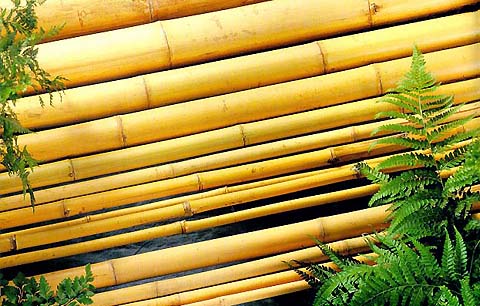SOURCE: JUAN WILSON juanwilson@mac.com
POSTED: 9 FEBRUARY 2006 - 12:00pm HST
Bamboo as building material

Bamboozled:
On bamboo flooring Got
questions about the environment? Ask Umbra.
|
INDEX - ENVIRONMENTwww.islandbreath.org ID# 0603-036
SUBJECT: GREEN CONSRUCTIONSOURCE: JUAN WILSON juanwilson@mac.com
POSTED: 9 FEBRUARY 2006 - 12:00pm HST
Bamboo as building material
Bamboozled: On bamboo flooring
by Umbra Fisk on 8 February 2006 in Grist MagazineGot questions about the environment? Ask Umbra.
Dear Umbra,
We will be putting in new flooring in the very near future. My first choice was hardwood, but I have recently read a lot about bamboo. Because it is renewable, it seems to be a better option. But how is it grown? Who is harvesting it? Are the people in the industry fair to their employees? Is it truly a better option for the environmentally conscious, or just a marketing tactic?
Kathleen DiBacco
Darien, Ill.
Dearest Kathleen,
Wood is a renewable resource, too, don't forget.
The bamboo situation is definitely interesting. I'm afraid that while bamboo has become another great choice, it is not a choice we can make blindly. Dang it.Bamboo ... not just for pandas anymore.
Bamboo is a grass primarily found in East and Southeast Asia, but also in other areas. It grows fast -- as much as three feet a day for some species. That sounds like a spectator sport! The plants reach harvestable maturity in three to six years. Round, hollow bamboo is cut into strips, boiled or soaked to get the starch out, dried, and laminated together. Then it just looks like fat, flat boards. You may have seen it in varying colors, which are achieved through steaming. I've seen some floors I like and others I find hideous, by which I conclude that there is a finish for every palate.
silky smooth bamboo flooring in natural hues
Bamboo has become a hot green material because of the general sense that it is harvested from well-managed plantations, where rhizomes endlessly replenish a diverse stand of plentiful flooring material. It is touted as a green solution, and a LEED-worthy one at that. Still, I think bamboo doesn't completely fit our fantasy of a perfect eco-material. The reality is that not all bamboo is the same, and we need to look at the source just as much as we do for wood. We have a great arbiter for wood in the Forest Stewardship Council. At this time, bamboo does not have a similar third-party certification process. That means death of the eco-fantasy, and we need to chase down the source of any bamboo we intend to buy.
If you are buying new bamboo flooring, it should be possible to hunt around for good vendors who are making an effort to encourage good harvest and planting practices. The troubles with bamboo could include removal of natural habitat to make way for plantations, monoculture plantations, sad workers, and use of biocides for weed suppression. The positive sides should also be mentioned: high-yield, sustainably grown crops, erosion control in some circumstances, and reliable income in poor areas. A decent bamboo purveyor should boast of their sources' attributes, and should be able to provide verification.
In short, bamboo is a great idea for flooring. It's not magically far better than FSC-certified or locally re-milled hardwood, however, and you'll need to look into the sources as you shop. Sorry.
Grassily,
Umbra
Pau